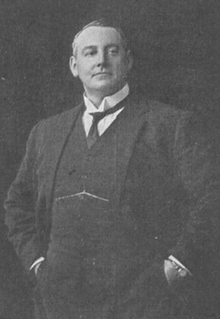Thomas Inch
Thomas Inch (27 December 1881 in Scarborough, England – 12 December 1963) was a British strongman, holding the titles of Britain's Strongest Youth and Britain's Strongest Man.[1]
Thomas Inch | |
|---|---|
 | |
| Born | 27 December 1881 |
| Died | 12 December 1963 |
| Occupation | Strongman |
Early life
Thomas Inch was born on December 17, 1881 in Scarborough, a seaside town on the North Yorkshire coast. He became interested in bodybuilding and strength as a young boy, bodybuilding through manual labour.[2]
Lifting career
In 1902, aged 19, Inch was declared by a major 'strongman' publication as the ‘World’s Strongest Youth, enhancing his notoriety. His inspirations included Eugen Sandow, having seen the German ripping a pack of cards in half and throwing the split deck into the audience. Inch was said to have caught one half of the pack, proceeded to split that in half in the audience, and throw is back at Sandow.[3]
Unlike many professional strongmen of his day, Inch focused on standard lifts with barbells and dumbbells and left the hoisting of wooden barrels, heavy sacks of grain, pianos, or holding back a team of horses, to his contemporaries. His one exception was that he sometimes lifted human beings in the bent-press; a complicated, one-hand movement to watch.
Book & Capitalisation on fame
Inch realized in order to advance his fame and fortune as a world class strongman he needed to meet the prerequisite of publishing a well-written book pertaining to physical fitness. This, he accomplished in 1907, by authoring "Thomas Inch on Strength." The following years, he traveled the British countryside performing exhibitions, selling his book, and spreading the Inch name.
Inch was responsible for establishing the first mail-order physical culture business in the UK.[4]
Britain's Strongest Man & World Records.
Inch went on to win the title of Britain’s Strongest Man on June 11, 1910. At the age of 68, Inch was still capable of deadlifting 540 pounds - an unofficial world record. His record lifts included a two hands anyhow of 356 1/2 pounds and a bent press of 304 1/2 pounds.[5]
The 'Thomas Inch' dumbbell
He is known for the Thomas Inch dumbbell, known as "172", a dumbbell that weighs 172 lbs and 9 ounces(78.27kg). It was extremely difficult to lift, partly due to its weight, but primarily because its handle was very thick (2 3/8 inches(6cm) in diameter) making it difficult to hold on to without an outstandingly strong grip. There were allegations that there was a hole in the original 'bell, in which Thomas would place a nail, allowing him to arrest any rotation whilst lifting it. On 22 June 2002 Olympic Weightlifter, professional wrestler and champion powerlifter Mark Henry completed a successful one-hand clean and jerk of the dumbbell.[6]
Inch claimed that in his lifetime he never encountered anyone who could lift the 172 from the floor to overhead using only one hand. Even further he claimed that no one could clear it off the floor. He said he had overheaded it literally 'hundreds of times' sometimes lifting it twice in the same performance.[7]
In 1909 Inch, still only a middleweight, refused to compete in a weightlifting match against the Austrian strongman Max Sick (Maxick), who had recently arrived in London. However, by 1910 Inch had become a heavyweight and so relinquished his middleweight title to Edward Aston, and a competition was quickly arranged against Sick.[8]
Selected publications
- Inch on Fitness (1923)
- Away with Nerves (1946)
- Manual of Physical Training (1947)
- Boxing for Beginners, from Novice to Champion (1951)
References
- "INCH 101: An Introduction To The Basics". Bodybuilding.com. 12 December 2006. Archived from the original on 16 September 2016. Retrieved 10 April 2020.
- Inch, Thomas (8 April 2012). Developing the Grip and Forearm. CreateSpace Independent Publishing Platform. ISBN 978-1-4751-2710-2.
- Klein, Alan M. Little Big Men: Bodybuilding Subculture and Gender Construction. SUNY Press. ISBN 978-1-4384-0925-2.
- Carter, Neil (2013). "Managing the Body: Beauty, Health and Fitness in Britain, 1880–1939". Sport in History. 33 (1): 101–104.
- Inch, Thomas (8 April 2012). Developing the Grip and Forearm. CreateSpace Independent Publishing Platform. ISBN 978-1-4751-2710-2.
- "Archived copy". Archived from the original on 16 January 2017. Retrieved 25 February 2019.CS1 maint: archived copy as title (link)
- Prowse, David (28 September 2011). Straight From The Force’s Mouth: The Autobiography of Dave Prowse. Andrews UK Limited. ISBN 978-1-908382-05-4.
- "Max Sick's biography on maxalding.co.uk". Archived from the original on 20 August 2012. Retrieved 10 April 2020.